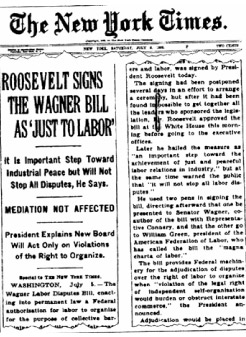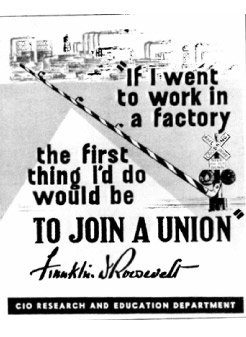The Wagner Act Is Best Described as a N
In February 1935 Wagner introduced the National Labor Relations Act in the Senate. The Wagner Act Again.

1935 Passage Of The Wagner Act National Labor Relations Board
The legislation was officially titled the National Labor Relations Act but it came to be referred to as the Wagner Act because New York Senator Robert Wagner sponsored the bill and convinced.

. Wagner Act officially National Labor Relations Act 1935 the most important piece of labour legislation enacted in the United States in the 20th century. The Wagner Act of 1935 popularly called the national Labor Relations Act is a vital piece of US labor legislation that allows private-sector workers to organize unions participate in collective bargaining and conduct collective action such as strikes. True Membership in the Knights of Labor was.
The National Labor Relations Act of 1935 known popularly as the Wagner Act was New Deal legislation designed to maintain industrial production by preventing labor strife. NATIONAL LABOR RELATIONS ACT Wagner Act Also cited NLRA or the Act. Wagner Act in order to reconstruct the vision of political economy ideology and law that impelled Robert Wagners crusade to build a cooperative social democracy.
It draws on historical evidence to il-luminate two issues currently at the center of labor law. Official name National Labor Relations Act in the USA the law regulating labor relations adopted on July 5 1935. The Wagner Act officially the National Labor __________ Act establishes the right for employees to form unions requires employers to bargain with such unions fairly and prohibits unfair labor practices such as firing employees for joining unions.
Radicalization of the Wagner Act and the Origins of Modern Legal Consciousness 1937-1941 3 is an example of such scholarship. Could arguably be described as ambiguous19 In such a situation. A recently published interview with Leon Keyserling underlines the role of Progressive liberal policy intellectuals mainly lawyers and economists in the discussions that led to the framing of.
He believes a few key people run the union by meeting secretly and making decisions without informing other members or allowing them to fully participate in the meetings. Named after its author Senator R. The National Labor Relations Act Wagner Act gave employees the right to form and join labor organizations and the right to engage in activities such as strikes and boycotts.
The Wagner Act also known as the National Labor Relations Act of 1935 29 USCA. The adoption of the Wagner Act was brought about by the attempt of the government of the USA to dampen the extremely sharp class contradictions associated with the world economic crisis of 1929-33. John belongs to a labor union.
Its purpose was to guarantee workers the right to organize Unions and to bargain collectively. Politics and Labor 193537 - Volume 3. 1935 passage of the Wagner Act.
The Wagner Bill proposed to create a new. The Wagner Act is best described as an. The Wagner Act is best described as an.
A better relationship between labor and management is the high purpose of this Act. It only excluded domestic and agricultural workers. Wagner act definition National Labor Relations Act.
It also instrumentally pointed the need for collective bargaining of the workers. By assuring the employees the right of collective bargaining it fosters the development of the employment contract on a sound and equitable basis. Asked Jan 16 2021 in History by mlj15.
Huthmacher describes the preparation of the bill in Robert F. In the fall of 1934 Senator Wagner began revising his labor disputes bill determined to build on the experience of the two earlier NIRA boards and to find a solution to the enforcement problem that had plagued them. It made the federal government the arbiter of employer-employee relations through the creation of the national labor relations board NLRB and recognized for the first time the right of workers to organize and.
Title 29 Chapter 7 Subchapter II United States Code FINDINGS AND POLICIES. The Wagner Act of 1935 also known as the National Labor Relations Act was enacted to protect workers from interference by industry in their involvement with unions. 151 et seq is the most important piece of labor legislation enacted in US.
The substan- tive controversy over the appropriate legal policy toward innovations. Jones and Laughlin established That the Taft-Hartley act was constitutional That the Wagner act was unconstituational That the Wagner act was constitutional That yellow-dog contract was illegal Flag this Question Question 521 pts As an HR manager you need to compare your organizations turnover with other. The wagner act established the legal rights of workers to organise into unions.
Question 511 pts The NLRB v. When FDR signed the National Labor Relations Act Wagner Act into law on July 5 1935 he declared. It protected the right of workers to organize and bargain collectively.
The Wagner Act also known as the National Labor Relations Act NLRA was passed as part of FDRs series of New Deal Programs. It also restricted the ways that employers could interfere and react to labor practices in the private sector including collective bargaining labor unions and striking. Its main purpose was to establish the legal right of most workers notably excepting agricultural and domestic workers to organize or join labour unions and to bargain collectively with their employers.
151 The denial by some employers of the right of employees to organize and the refusal by some employers to accept the procedure of collective bargaining lead to. Or at best inconclusive about the meaning of most of the key terms and phrases of the bill2 8 At the very least Klare contends there existed.

Wagner Act Summary History Facts Britannica

1935 Passage Of The Wagner Act National Labor Relations Board

Comments
Post a Comment